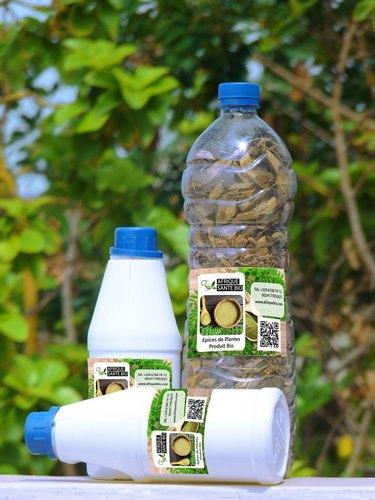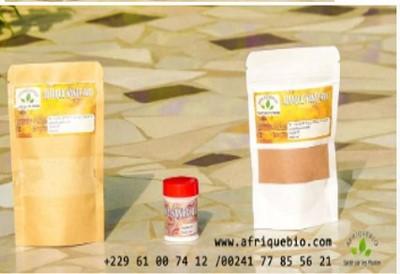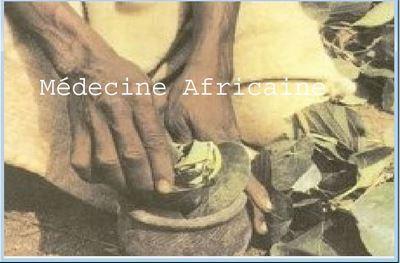Herbal Tea 369: Compartment syndrome natural treatment
This is an excellent natural treatment for compartment syndrome that cures and cures the pain associated with compartment syndrome. The treatment consists of 100% medicinal herbs
You suffer from compartment syndrome so here is an excellent natural treatment for compartment syndrome that cures and cures the pain associated with compartment syndrome or muscular compartment syndrome. The treatment consists of 100% medicinal herbs and effectively cures this condition occurring during exercise. This pathology, also called compartment syndrome, is due to excessive swelling of an overstressed muscle, which finds itself cramped in its inextensible "compartment". Thus, compartment syndrome occurs when a muscle is too cramped in its compartment or compartment
Please write to us to buy the herbal tea 369: Compartment syndrome natural treatment Compartment syndrome
Please reach us at http://wa.me//+22967546677
Click below to order clove oil
Book an appointment with lady feranmi on
30,00€ excl. tax - 30,00€ inc. tax
- Condition : new
- Supplier : Afrique-bio.
- Manufacturer : Afrique-bio
Loges syndrome (Compartmental): Definition
What is Compartment Syndrome?
Compartment syndrome is by an increase in the pressure in an inextensible fascial compartment which induces muscular ischemia in the compartment. This is a serious pathology that occurs when there is a large pressure inside a muscular compartment. The first manifestation is sudden pain regardless of the degree of trauma. The result is very sharp pain leading to the cessation of the sport in question. The increase in the volume of the muscle may be linked to muscle contraction, the formation of edema or hematoma, or even venous or muscular abnormalities. Compartment syndrome doctors are underdiagnosed.
Please write to us to buy the Remedy Compartment Syndrome natural treatment Compartment Syndrome
call 0022967546677 to order the natural treatment, Syndrome des Loges
What are compartments or boxes?
These are groups of muscle tissue, nerves, and blood vessels in your arms and legs surrounded by a strong membrane called ‘fascia’. The fascia does not dilate, so swelling in one compartment may cause pressure inside the compartment to increase. This results in injuries to muscles, blood vessels, and nerves within the compartment.
Click here to contact us to buy the Remedy Naturel Syndrome de Loges
If you would like to contact our sales department via voice or video call for further assistance, then click on the CALL button
Increased pressure may cut off blood flow to the compartment. This can lead to loss of oxygen in the tissues (ischemia) and cell death (necrosis)
Please reach us at http://wa.me//+22967546677
Click below to order clove oil
Book an appointment with lady feranmi on
Compartment Syndrome: Causes Compartment Syndrome Natural Treatment
Causes of Compartment Syndrome
It results from conflict, bleeding, or swelling in a muscular compartment or compartment. That is to say a conflict between the container (fascia) and the contents (muscle tissue, but also nerves and blood vessels). That This causes pressure to build up inside the compartment, which can interfere with blood flow. This causes permanent damage if it is not treated because the muscles and nerves will not be well nourished. Failure to treat the disease can lead to amputation. Abnormalities in the container, such as a thickened fascia due to fibrosis or trauma, may also be involved.
Related Searches
Compartment Syndrome, Compartment Syndrome, Compartment Syndrome, Compartment Syndrome Natural Treatment Compartment Syndrome, Compartment Syndrome definition, what compartment syndrome is, Why compartment syndrome, When compartment syndrome appears, How to diagnose compartment syndrome, What is a doctor for compartment syndrome, How to tell if you have compartment syndrome, What is compartment syndrome, What is a doctor for compartment syndrome, What are the signs of Volkmann syndrome
Please click on important to discover a recipe
Please reach us at http://wa.me//+22967546677
Click below to order clove oil
Book an appointment with lady feranmi on
Types of Compartment Syndrome Natural Treatment Compartment Syndrome
Acute Compartment Syndrome Natural Treatment Compartment Syndrome
Acute compartment syndrome usually occurs after a serious injury. Rarely, it can also develop after a minor injury or snakebite. For example, you may develop acute compartment syndrome:
- after a fracture; Severe bruising or crush injury Reperfusion injury after vascular repair
- after an injury that crushes your arm or leg;
- following a severely bruised muscle;
- snakebites, burns, strenuous exercise, drug overdoses (heroin or cocaine), casts,
- to wear a cast or tight bandage;
- Prolonged pressure on a muscle during coma can cause rhabdomyolysis.
- excessive use of alcohol or drugs
Tea 369: Remedy Compartment syndrome natural treatment Compartment syndrome remains the best natural treatment compartment syndrome of the plant kingdom
Chronic compartment syndrome or Exercise-induced syndrome Natural treatment Loge syndrome
Exercise, especially when involving repetitive movements, can cause this form of compartment syndrome. It most often occurs in people under 40, but you can develop it at any age.
You are at a higher risk of developing chronic compartment syndrome if you practice activities such as swimming, tennis, or running. Intense or frequent workouts may also increase your risk.
The link between exercise and chronic compartment syndrome is not fully understood.
Please reach us at http://wa.me//+22967546677
Click below to order clove oil
Book an appointment with lady feranmi on
Manifestation of Compartment Syndrome Natural Treatment Compartment Syndrome
Acute compartment syndrome Natural remedy Compartment syndrome
In acute compartment syndrome, the most common symptom is severe pain that does not improve after maintaining the injured area elevated or after taking drugs. Your leg or arm may feel worse when you stretch it or use the injured muscle. That is, the acute form is related to a sudden increase in pressure following trauma or to excessive compression by a bandage or cast, causing muscle engorgement. Volkmann syndrome occurs when it affects a cast forearm. The compression element must be removed as soon as possible.
Other Signs of Acute Compartment Syndrome
Sometimes there is a feeling of tightness in the muscle or a tingling or burning sensation in the skin around the affected area. Numbness or paralysis is also noted. This is usually a sign of permanent damage. Acute compartment syndrome requires immediate medical attention to relieve the pressure. Permanent damage to your muscles and nerves can develop within hours. This is a surgical emergency and may require amputation if not treated immediately.
Tea 369: Natural Treatment For Loge Syndrome remains the right choice
Please reach us at http://wa.me//+22967546677
Click below to order clove oil
Book an appointment with lady feranmi on
Symptoms of Compartment Syndrome Natural Treatment Compartment Syndrome
Chronic compartment syndrome
Here, the effort directly leads to an excessive increase in the volume of the muscle, reversible within a variable period after its cessation. The calf is the most common location. Disorders are bilateral in 50 to 80% of cases. Pain or cramps when you exercise are the most common symptom of chronic compartment syndrome. After stopping exercise, pain or cramps usually resolve within 30 minutes. If you continue to do the activity that causes this condition, the pain may start to last longer.
Other symptoms of Compartment Syndrome may include:
have difficulty moving your foot, arm, or affected area; numbness; noticeable bulging in the affected muscle
Treatment of Chronic Compartment Syndrome
Chronic compartment syndrome is not considered an emergency, but you should tell your doctor if you have symptoms. Do not try to exercise when you are in pain, as it can cause permanent damage to your muscles, blood vessels, and nerves.
If the dressing causes tingling or numbness, remove and wrap it more loosely. It should not be so tight that it causes discomfort or interferes with your blood circulation. Even gentle compression may help prevent fluid from accumulating around the wound.
Feel free to write to us or call us by clicking HERE for further assistance.
How To Prevent Compartment Syndrome
No brutal exercises. Proper warming up, and stretching exercises as well as a sporting practice adapted to his abilities, with a very gradual increase in the intensity and duration of the efforts, help prevent compartment syndrome.
Please reach us at http://wa.me//+22967546677
Click below to order clove oil
Book an appointment with lady feranmi on
Compartment Syndrome Natural Treatment Compartment Syndrome
Natural Treatment Acute Compartment Syndrome
Unfortunately, surgery is the only treatment option for this type of compartment syndrome. The process involves opening the fascia to reduce pressure in the compartment. In severe cases, your doctor will have to wait until the swelling subsides before closing the incision, and some of these wounds require skin grafting.
If you developed this condition because of a tight cast or bandage, the material will need to be removed or loosened.
Natural Treatment Chronic Compartment Syndrome
You can:
- Change the type of surface you train on.
- Perform low-impact activities as part of your exercise routine
- elevation of the tip;
- rest after the activity or modify the activity;
- end icing after the activity
- If these methods don't work, you may need surgery.
Source Health Passport
What else to do for Compartment Syndrome
Rest to Treat Compartment Syndrome
Rest is one of the most effective ways to start your healing process. Your injured muscle will be weak and vulnerable to further injury, especially in the first few hours. Take a break before moving it to help it heal.
Ice for Relieving Compartment Syndrome
The benefits of applying ice are greatest during the first day or two after injury.
Apply a bag of crushed ice, a bag of frozen vegetables, or a bag of ice to your wound. It will help relieve pain and prevent swelling by decreasing blood flow to the area.
To avoid frostbite, never place ice directly on your bare skin. Instead, wrap it in a thin cloth or towel before applying it to the injured area.
Apply ice for 15 to 20 minutes at a time and let your skin return to a normal temperature between the glazes.
Pain relief pack
An elastic bandage wrapped tightly around your wound can help minimize swelling by preventing the accumulation of fluid. It can also help relieve pain by keeping the injured area somewhat immobilized. The bandage may not be enough to fully immobilize the injured area, but it will provide some support and remind you not to move.
Natural Treatment Acute Compartment Syndrome
Unfortunately, surgery is the only treatment option for this type of compartment syndrome. The process involves opening the fascia to reduce pressure in the compartment. In severe cases, your doctor will have to wait until the swelling subsides before closing the incision, and some of these wounds require skin grafting.
If you developed this condition because of a tight cast or bandage, the material will need to be removed or loosened.
Please reach us at http://wa.me//+22967546677
Click below to order clove oil
Book an appointment with lady feranmi on
Natural Treatment Chronic Compartment Syndrome
You can:
- Change the type of surface you train on.
- Perform low-impact activities as part of your exercise routine
- elevation of the tip;
- rest after the activity or modify the activity;
- end icing after the activity
- If these methods don't work, you may need surgery.
Source Health Passport
What else to do for Compartment Syndrome
Rest to Treat Compartment Syndrome
Rest is one of the most effective ways to start your healing process. Your injured muscle will be weak and vulnerable to further injury, especially in the first few hours. Take a break before moving it to help it heal.
Ice for Relieving Compartment Syndrome
The benefits of applying ice are greatest during the first day or two after injury.
Apply a bag of crushed ice, a bag of frozen vegetables, or a bag of ice to your wound. It will help relieve pain and prevent swelling by decreasing blood flow to the area.
To avoid frostbite, never place ice directly on your bare skin. Instead, wrap it in a thin cloth or towel before applying it to the injured area.
Apply ice for 15 to 20 minutes at a time and let your skin return to a normal temperature between the glazes.
Pain relief pack
An elastic bandage wrapped tightly around your wound can help minimize swelling by preventing the accumulation of fluid. It can also help relieve pain by keeping the injured area somewhat immobilized. The bandage may not be enough to fully immobilize the injured area, but it will provide some support and remind you not to move.
Natural Treatment Acute Compartment Syndrome
Unfortunately, surgery is the only treatment option for this type of compartment syndrome. The process involves opening the fascia to reduce pressure in the compartment. In severe cases, your doctor will have to wait until the swelling subsides before closing the incision, and some of these wounds require skin grafting.
If you developed this condition because of a tight cast or bandage, the material will need to be removed or loosened.
Natural Treatment Chronic Compartment Syndrome
You can:
- Change the type of surface you train on.
- Perform low-impact activities as part of your exercise routine
- elevation of the tip;
- rest after the activity or modify the activity;
- end icing after the activity
- If these methods don't work, you may need surgery.
- Source Health Passport
- What else to do for Compartment Syndrome
- Rest to Treat Compartment Syndrome
- Rest is one of the most effective ways to start your healing process. Your injured muscle will be weak and vulnerable to further injury, especially in the first few hours. Take a break before moving it to help it heal.
- Ice for Relieving Compartment Syndrome
- The benefits of applying ice are greatest during the first day or two after injury.
- Apply a bag of crushed ice, a bag of frozen vegetables, or a bag of ice to your wound. It will help relieve pain and prevent swelling by decreasing blood flow to the area.
- To avoid frostbite, never place ice directly on your bare skin. Instead, wrap it in a thin cloth or towel before applying it to the injured area.
- Apply ice for 15 to 20 minutes at a time and let your skin return to a normal temperature between the glazes.
- Pain relief pack
- An elastic bandage wrapped tightly around your wound can help minimize swelling by preventing the accumulation of fluid. It can also help relieve pain by keeping the injured area somewhat immobilized. The bandage may not be enough to fully immobilize the injured area, but it will provide some support and remind you not to move.
- Natural Treatment Acute Compartment Syndrome
- Unfortunately, surgery is the only treatment option for this type of compartment syndrome. The process involves opening the fascia to reduce pressure in the compartment. In severe cases, your doctor will have to wait until the swelling subsides before closing the incision, and some of these wounds require skin grafting.
- If you developed this condition because of a tight cast or bandage, the material will need to be removed or loosened.
- Natural Treatment Chronic Compartment Syndrome
- You can:
- Change the type of surface you train on.
- Perform low-impact activities as part of your exercise routine
- elevation of the tip;
- rest after the activity or modify the activity;
- end icing after the activity
- If these methods don't work, you may need surgery.
- Source Health Passport
- What else to do for Compartment Syndrome
- Rest to Treat Compartment Syndrome
- Rest is one of the most effective ways to start your healing process. Your injured muscle will be weak and vulnerable to further injury, especially in the first few hours. Take a break before moving it to help it heal.
- Ice for Relieving Compartment Syndrome
- The benefits of applying ice are greatest during the first day or two after injury.
- Apply a bag of crushed ice, a bag of frozen vegetables, or a bag of ice to your wound. It will help relieve pain and prevent swelling by decreasing blood flow to the area.
- To avoid frostbite, never place ice directly on your bare skin. Instead, wrap it in a thin cloth or towel before applying it to the injured area.
- Apply ice for 15 to 20 minutes at a time and let your skin return to a normal temperature between the glazes.
- Pain relief pack
- An elastic bandage wrapped tightly around your wound can help minimize swelling by preventing the accumulation of fluid. It can also help relieve pain by keeping the injured area somewhat immobilized. The bandage may not be enough to fully immobilize the injured area, but it will provide some support and remind you not to move.
- Natural Treatment Acute Compartment Syndrome
- Unfortunately, surgery is the only treatment option for this type of compartment syndrome. The process involves opening the fascia to reduce pressure in the compartment. In severe cases, your doctor will have to wait until the swelling subsides before closing the incision, and some of these wounds require skin grafting.
- If you developed this condition because of a tight cast or bandage, the material will need to be removed or loosened.
- Natural Treatment Chronic Compartment Syndrome
- You can:
- Change the type of surface you train on.
- Perform low-impact activities as part of your exercise routine
- elevation of the tip;
- rest after the activity or modify the activity;
- end icing after r activity
- If these methods don't work, you may need surgery.
Source Health Passport
What else to do for Compartment Syndrome
Rest to Treat Compartment Syndrome
Rest is one of the most effective ways to start your healing process. Your injured muscle will be weak and vulnerable to further injury, especially in the first few hours. Take a break before moving it to help it heal.
Ice for Relieving Compartment Syndrome
The benefits of applying ice are greatest during the first day or two after injury.
Apply a bag of crushed ice, a bag of frozen vegetables, les or a bag of ice to your wound. It will help relieve pain and prevent swelling by decreasing blood flow to the area.
To avoid frostbite, never place ice directly on your bare skin. Instead, wrap it in a thin cloth or towel before applying it to the injured area.
Apply ice for 15 to 20 minutes at a time and let your skin return to a normal temperature between the glazes.
Pain relief pack
An elastic bandage wrapped tightly around your wound can help minimize swelling by preventing the accumulation of fluid. It can also help relieve pain by keeping the injured area somewhat immobilized. The bandage may not be enough to fully immobilize the injured area, but it will provide some support and remind you not to move.
Natural Treatment Acute Compartment Syndrome
Unfortunately, surgery is the only treatment option for this type of compartment syndrome. The process involves opening the fascia to reduce pressure in the compartment. In severe cases, your doctor will have to wait until the swelling subsides before closing the incision, and some of these wounds require skin grafting.
If you developed this condition because of a tight cast or bandage, the material will need to be removed or loosened.
Natural Treatment Chronic Compartment Syndrome
You can:
- Change the type of surface you train on.
- Perform low-impact activities as part of your exercise routine
- elevation of the tip;
- rest after the activity or modify the activity;
- end lithe ng after activity
- If these methods don't work, you may need surgery.
Source Health Passport
What else to do for Compartment Syndrome
Rest to Treat Compartment Syndrome
Rest is one of the most effective ways to start your healing process. Your injured muscle will be weak and vulnerable to further injury, especially in the first few hours. Take a break before moving it to help it heal.
Ice for Relieving Compartment Syndrome
The benefits of applying ice are greatest during the first day or two after injury.
Apply a bag of crushed ice, a bag of frozen vegetables, or a bag of ice to your wound. It will help relieve pain and prevent swelling by decreasing blood flow to the area.
To avoid frostbite, never place ice directly on your bare skin. Instead, wrap it in a thin cloth or towel before applying it to the injured area.
Apply ice for 15 to 20 minutes at a time and let your skin return to a normal temperature between the glazes.
Pain relief pack
An elastic bandage wrapped tightly around your wound can help minimize swelling by preventing the accumulation of fluid. It can also help relieve pain by keeping the injured area somewhat immobilized. The bandage may not be enough to fully immobilize the injured area, but it will provide some support and remind you not to move.
Natural Treatment Acute Compartment Syndrome
Unfortunately, surgery is the only treatment option for this type of compartment syndrome. The process involves opening the fascia to reduce pressure in the compartment. In severe cases, your doctor will have to wait until the swelling subsides before closing the incision, and some of these wounds require skin grafting.
If you developed this condition because of a tight cast or bandage, the material will need to be removed or loosened.
Natural Treatment Chronic Compartment Syndrome
You can:
- Change the type of surface you train on.
- Perform low-impact activities as part of your exercise routine
- elevation of the tip;
- rest after the activity or modify the activity;
- end icing after r activity
If these methods don't work, you may need surgery.
Source Health Passport
What else to do for Compartment Syndrome
Rest to Treat Compartment Syndrome
Rest is one of the most effective ways to start your healing process. Your injured muscle will be weak and vulnerable to further injury, especially in the first few hours. Take a break before moving it to help it heal.
Ice for Relieving Compartment Syndrome
The benefits of applying ice are greatest during the first day or two after injury.
Apply a bag of crushed ice, a bag of frozen vegetables, or a bag of ice to your wound. It will help relieve pain and prevent swelling by decreasing blood flow to the area.
To avoid frostbite, never place ice directly on your bare skin. Instead, wrap it in a thin cloth or towel before applying it to the injured area.
Apply ice for 15 to 20 minutes at a time and let your skin return to a normal temperature between the glazes.
Pain relief pack
An elastic bandage wrapped tightly around your wound can help minimize swelling by preventing the accumulation of fluid. It can also help relieve pain by keeping the injured area somewhat immobilized. The bandage may not be enough to fully immobilize the injured area, but it will provide some support and remind you not to move.
Natural Treatment Acute Compartment Syndrome
Unfortunately, surgery is the only treatment option for this type of compartment syndrome. The process involves opening the fascia to reduce pressure in the compartment. In severe cases, your doctor will have to wait until the swelling subsides before closing the incision, and some of these wounds require skin grafting.
If you developed this condition because of a tight cast or bandage, the material will need to be removed or loosened.
Natural Treatment Chronic Compartment Syndrome
You can:
- Change the type of surface you train on.
- Perform low-impact activities as part of your exercise routine
- elevation of the tip;
- rest after the activity or modify the activity;
- end icing after the activity
- If these methods don't work, you may need surgery.
Source Health Passport
What else to do for Compartment Syndrome
Rest to Treat Compartment Syndrome
Rest is one of the most effective ways to start your healing process. Your injured muscle will be weak and vulnerable to further injury, especially in the first few hours. Take a break before moving it to help it heal.
Ice for Relieving Compartment Syndrome
The benefits of applying ice are greatest during the first day or two after injury.
Apply a bag of crushed ice, a bag of frozen vegetables, or a bag of ice to your wound. It will help relieve pain and prevent swelling by decreasing blood flow to the area.
To avoid frostbite, never place ice directly on your bare skin. Instead, wrap it in a thin cloth or towel before applying it to the injured area.
Apply ice for 15 to 20 minutes at a time and let your skin return to a normal temperature between the glazes.
Pain relief pack
An elastic bandage wrapped tightly around your wound can help minimize swelling by preventing the accumulation of fluid. It can also help relieve pain by keeping the injured area somewhat immobilized. The bandage may not be enough to fully immobilize the injured area, but it will provide some support and remind you not to move.
Add a comment











